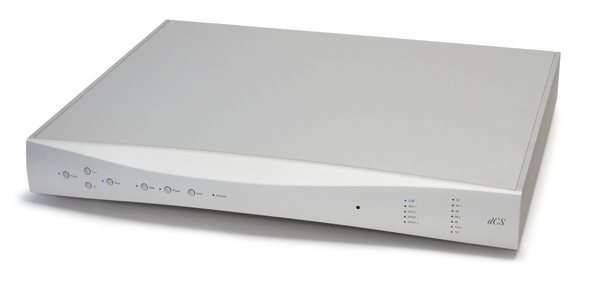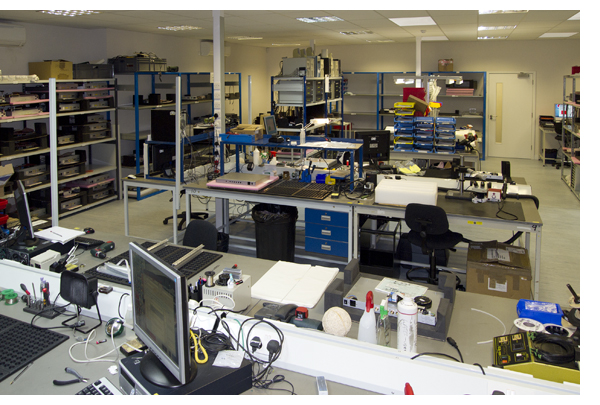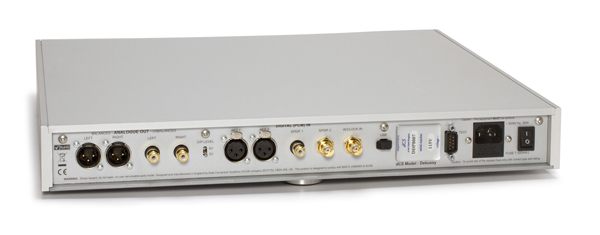dCS Debussy DAC Single Box Elegance
By Jeff Dorgay Computer audio has grown exponentially in the last few years, its orbit quickly accelerating over the past 18 months. Since they provide many ways to serve CD and high-res digital files, DACs have become the center of this universe. Once headed towards extinction, they’ve become a primary component in many systems, vinyl-centric or not.
Computer audio has grown exponentially in the last few years, its orbit quickly accelerating over the past 18 months. Since they provide many ways to serve CD and high-res digital files, DACs have become the center of this universe. Once headed towards extinction, they’ve become a primary component in many systems, vinyl-centric or not.
An abundance of sub-$1,000 DACs currently exists, similar to the plethora of turntables in the same price range. But, just like in the analog world, if you want cutting-edge sound, there’s a price to be paid. While some argue that with so much evolution, the $11,495 price on the dCS Debussy is a bit much, I beg to differ.
Again, using analog as the benchmark, things become spellbinding as you hover around the $10-$15k mark. It’s where the distinction between the digital and analog worlds blurs—especially for those building a serious collection of high-resolution music files. Even five years ago, there wasn’t much digital available at any price that sounded natural. Technology trickle-down is solid, albeit not at a level at which every audiophile can participate.
As a four-box dCS Paganini owner, to me the Debussy seems like a bargain, especially if you no longer spin silver discs. And even more so if you haven’t any need for an analog front end and use the Debussy as a control center, eschewing a line-level preamplifier. A prodigious system can be built around the Debussy, a pair of $10,000 speakers, and suitable power amplifier, which is precisely what I did.
The Debussy spent half of its evaluation in my reference system in direct comparison to the Paganini (with and without the Paganini Master Clock) to explore the ultimate limits of its performance. The other half of the review involved the Verity Audio Rienzi speakers ($10k/pair) and Conrad Johnson MV-50C1 power amplifier. Adding a pair of Cardas Clear Light interconnects, speaker cables, two Shunyata Venom 3 power cords, and a Running Springs Elgar power conditioner made for a highly impressive system that came in just under $25k.
Ins and Outs
The Debussy boasts five digital inputs: an RCA SPDIF, BNC SPDIF, USB, and pair of balanced AES/EBU inputs. All accept 24/96, and the USB and Dual AES interfaces are 24/192 capable. (A single-wire 24/192 software-only update is in development.) The balanced AES inputs can be used in single or dual configuration. The FireWire input of the Paganini is absent but should not be an issue for most users.
Aesthetically, dCS forgoes the mirror finish of its two top line systems in favor of a matte silver finish with black writing that is far easier to read than the markings on the Paganini. After living with the mirrored-surface Paganini, I’d have picked the silver had it been an option. It shows off the Debussy’s smart, curved design, yet it’s more resistant to fingerprints.
The learning curve on the Debussy is less daunting than that on the Paganini, which has more buttons than Sebastian Vettel’s steering wheel. Here, we get power, input, mute, volume+/-, and two DSP filter choices—linear phase with pre-ringing or non-linear phase without pre-ringing. Which is optimum? Log onto an Internet forum and knock yourself out.
As in all dCS DACs, the Debussy uses its proprietary Ring DAC, ultimately oversampling all incoming data to 2.822 or 3.07MHz with a 5-bit depth. When touring the dCS factory, I learned all the DACs share a common “motherboard.” The basic chipset and layout are the same, with more functionality as you go up the range. Such a strategy keeps manufacturing streamlined and designs future-proofed. All updates can be executed via software, further ensuring the unit’s longevity.
These benefits were the paramount reasons I chose dCS for my reference system. With so much change in the digital world, knowing my DAC could stay current by merely downloading new software made it that much easier to write a big check.
Should you use the Debussy as a preamplifier/control center, the digital volume control works brilliantly, with no degradation to the sound even at low listening levels. A switch on the rear panel offers the choice of 2V or 6V output. I can’t imagine anyone needing 6V, and would prefer to see the choices as 1V or 2V, especially with today’s amplifiers having so much gain.
Touring the dCS Factory
Earlier this year, I visited dCS’ new factory in Cambridge. The bigger facility condenses all manufacturing to one level, greatly streamlining build and test processes. Company principal David Steven and Sales Manager Rav Bawa were great hosts, showing off how much dCS grew since I toured the previous facility in 2010. Bawa explains that “assembly centers around a kit of parts, so that a box can be easily followed from beginning to end with one operator. In the old building, we had to go up and down stairs. You can imagine how nerve wracking that got, considering how heavy some of our components are.”
dCS sources mechanisms from Esoteric and keeps a substantial cache of spares on hand in the unlikely event one fails. Casework is machined and anodized nearby, with all engineering, assembly, and testing done in-house. dCS employs around 20 people and ships digital hardware to over 40 countries. When we walked through the shipping department, almost 100 boxes were on their way to dealers worldwide.
All dCS DACs use the same basic circuit board, with different software loaded for various iterations of the final product. Various assembly stations build and test, and the complete unit is tested yet again when complete. Ironically, because of the virtually nonexistent distortion and jitter in its products, dCS must design and build all of its test equipment. Finished components are burned-in for 48 hours and run through rigorous tests before final packing and shipment.
Due to its popularity, I figured the new Bon Iver record a perfect place to begin listening. “Holocene” possesses a wide soundstage with guitars panned to the left and right in the mix. Comparing the CD to the LP proved a close heat, with the Debussy doing an excellent job at keeping what little front-to-back dimension that exists intact. Black Country Communion’s first, self-titled album duplicates the experience. The vinyl sounds decent but not overwhelming, and much like when paired with the first Fleet Foxes record or Tom Jones’ Praise and Blame, the Debussy gets the nod in terms of providing a more liquid presentation, with more extension on the top and bottom ends of the tonal scale.
As with the Paganini, the big surprise arrives when listening to fairly dreadful digital recordings. The Debussy pulls tons of detail from recordings I believed completely lacking such information. Yes, my Japanese copy of Kiss’ Alive! sounds better than ever. Quite possibly the most highly compressed CD in my collection, the self-titled album from Glenn Hughes and Pat Thrall, now leaves me astonished that air actually lurks on the disc.
However good the Debussy is at untangling dense recordings, it does not embellish tonally to either side of neutral. If you’d like a bit of warmth added to the sound of digital files, look to one of the more popular players featuring vacuum tubes in the output stage. But my experience has been that these players give up resolution and transient clarity in return. The Debussy gives you the truth, like it or not.
Like the other players in dCS’ lineup, the Debussy is not harsh or clinical. The best digital recordings in your collection will sound virtually indistinguishable, if not better, than favorite analog files. Charlie Haden’s The Private Collection (Naim) is excellent for comparison purposes since it is manufactured to an equally high level in analog and digital formats. And now, you can purchase it as a 24/96 download.
Comparing the high-res file played through the Paganini gives the advantage to the dCS stack in terms of sonic dynamics and overall cleanliness. The Debussy comes close, and with the addition of the dCS Paganini Master Clock (an additional $8,000), takes the lead in overall musicality. While I consider myself a devoted analog fan, it’s easy to lose sight of the fact that a lot of records are poorly produced, no matter the generation.
Making similar comparisons between MoFi’s recent remaster of Beck’s Sea Change and the high-resolution files available from HD Tracks uncover revealingly indistinguishable results. The sources are even more similar in sound when I contrast a digital copy I made from the MoFi pressing, recorded to a 24/192 file via Nagra’s LB studio recorder. Even friends with canine-like hearing have a tough time determining the analog pressing from the high-resolution digital copy.
As it does in my Paganini stack, the Master Clock offers extra tonal ease and pace. An early British pressing of Elton John’s Goodbye Yellow Brick Road put against to the latest HD Tracks download shows the digital file again yields more music. The gulls in the background of “Sweet Painted Lady” possess a previously absent palpability, and the bass line stays firmly anchored compared to its somewhat nebulous position on LP.
dCS also offers nearly bottomless bass grip when playing my favorite Deadmau5 and Thievery Corporation tracks. The deep bass on these albums doesn’t come through well on LP, and if it does, no matter how good your turntable might be, at club-level volume, feedback intrudes on the party and greatly diminishes the effect.
I don’t plan on getting rid of my turntables anytime soon, but it is wonderful to know that this level of parity is attainable. Thanks to dCS and a few other great combinations I’ve heard, my analog agnosticism is put to rest. Granted, $10-20k is not a casual purchase for most carbon-based life forms. But a similar investment in the analog domain is necessary to get maximum performance. Digital has matured far beyond the point where your average turntable outperforms a high-dollar digital front end. As always, the recording quality will determine which source gets the nod, but you’ll never have to “settle” for digital with the Debussy.
The dCS Debussy equates to a triumph, bringing world- class digital performance to a price point previously out of most audiophiles’ reach. But don’t listen to the Master Clock unless you are ready to press the “buy now” button. Once you’ve had such insight, it’s tough to go back to listening without it.
If one could exchange their CD and LP collection for high-quality, high-resolution files, this would be an easy choice to make. But it’s not that easy. Yet. For those that already have a substantial collection of 16/44 digital files, whether ripped on a hard drive or from CD, the Deb makes it easy to not only enjoy them like never before, but to obtain the necessary amount of air and warmth that you enjoy from analog sources. The experience allows you to listen for hours without fatigue. And I can’t give a source component a higher recommendation than that.
dCS Debussy $11,495
Data Conversion Systems, Ltd.
dCS North America, LLC
Peripherals
| Preamplifier | Audio Research REF 5 |
| Power Amplifiers | Audio Research REF 150 Conrad Johnson MV-50C1 |
| Speakers | GamuT S9 Verity Audio Rienzi |
| Cable | Cardas Clear Shunyata Aurora |
| Power | Running Springs Dmitri and Maxim Elgar PLCs |





